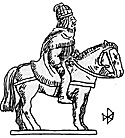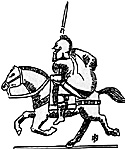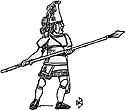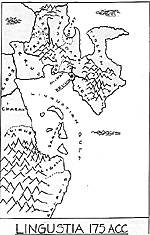Why it took me almost 21 years to join the SWA puzzles me. You see my earliest memory of warfare as an interest was in a book on the campaigns of Alexander the Great. It had lots of detailed maps with the usual symbols for Infantry, Cavalry, Chariots and Elephants, and also the movement arrows depicting the stages of each battle or campaign. My earliest memory of model soldiers was a book by Lawford and Young - "Charge! - or how to play wargames". The bit that really interested me in that book was what happened after Lentulus' defeat i.e. how did the rest of the campaign go. I did not realise that at that time because the battles and the painted soldiers seemed more attractive. So I ended up collecting figures and fighting battles.
Initially these were solo affairs; the figures remained unpainted as it always seemed so time consuming! Eventually I joined a club but the painting did not improve. I acquired Don Featherstone's books on Solo Wargaming and Campaigns but always with the objective of fighting it out with figurines. Then I happened upon TTG's micro ancients and coupled this with a 1980's Slingshot article by Tony Bath which used just a six sided die and a list of outcomes between various troop types and I was finally realising that the campaign aspect of wargaming was more important to me than the figures. But I'm not a board gamer, no offence meant! And if I had the time I would fight all my battles with painted figures. The trouble is the next campaign always gets in the way of painting.
The first real campaign using the TTG and Tony Bath rules was excellent in fighting the battles. But having bought Tony Bath's "Setting up a Wargames Campaign", the ideas on supply, geography, mobilising, financing, not to mention character maintenance nearly sank me! 1980's Slingshot articles were rediscovered to, especially those by Jim Webster. Taken altogether, while my battles were now completed in an evening, the campaign to get to the battlefield was taking forever! At its height it took me a year to fight six months of the campaign. Now again you might argue that if it was enjoyable why worry? It was enjoyable to a point - but sustaining interest was proving difficult - a sure sign that I was not satisfied. I am happy to say that the particular campaign has been finished successfully, but only after a pilot campaign which I will now describe.
My requirement with the limited time I have available is to wargame a campaign that covers decades. Therefore, many of the rules I have used in the past failed to work because they were daily!!.. or weekly or monthly orientated as were all the other activities which could make for an exciting campaign. So it was that last year I went to my local wargames show and bought some figures (still unpainted) and picked up an SWA flyer.
Finally, coming to terms with the fact I was a solo wargamer first and foremost, I joined. Steve Moore sent me very promptly some back editions of Lone Warrior for the year I had enrolled. In one of these was Steve Foster's "Blobs" (LW 112) minus the diagrams [in Lone Warrior 113]. But that didn't matter, reading his article made me realise that even my detailed hex maps were a hindrance to wargaming in decades and yet fighting the battles in the odd 2 or 3 hours or even one hour slots of time I had available. I can't remember why I obtained LW 110 but this contained Ian Duncan's "Solo DBA Campaigns". This was exactly what I needed. Just to show you how "solo" I have become, the only thing I did not understand about the article was DBA! This was soon rectified by a purchase of the DBA set of rules. They turned out to be exactly what I wanted.
Armed with the DBA rules, Ian Duncan's additions plus the blob concept, I returned to my current campaign. As I was in the midst of a war with all the complications of family trees, population growth, supply, reinforcements, trade, etc. I decided to campaign in a different area first, to see whether I liked the rules. The subsequent 21 year war was over in no time at all by my standards but without loss of interest on my part. A die throw, here or there, replaced extensive supply and logistics records and calculations. Having said that, little nuggets of detail on which turned events of magnitude in my main campaign could not be created with the more simplified rules but on the whole I was very pleased with the result.
FELOS
 My imaginary world is called Felos and it was created very crudely to start with as the background to a medieval campaign which never got going. A major decision was that most of the mapped area had been conquered by an Empire but that it had declined due to an external aggressor and internal dissension. The original campaign had centred on the conflict between the external aggressor and one of the successor kingdoms at the empire's frontier. For my first foray with DBA, I turned to the heart of the Empire where in 173ACC the 3rd Lingustian Civil War was about to begin. I will let Perec, the great sage of Delium, take up the story.
My imaginary world is called Felos and it was created very crudely to start with as the background to a medieval campaign which never got going. A major decision was that most of the mapped area had been conquered by an Empire but that it had declined due to an external aggressor and internal dissension. The original campaign had centred on the conflict between the external aggressor and one of the successor kingdoms at the empire's frontier. For my first foray with DBA, I turned to the heart of the Empire where in 173ACC the 3rd Lingustian Civil War was about to begin. I will let Perec, the great sage of Delium, take up the story.
Lagast, Emperor of Lingustia had ruled solidly for 29 years ending 23 years of turmoil under various usurpers when the very heart of the Empire seemed about to breathe its last. Lagast, with the assistance of his energetic brother Sandor, had stabilised what was left of the kingdom and finally re-established control of the original seven princedoms which were known as Lingustia. They were Calanis in the south, Charax in the west, Mira in the north, Istros and Gelost with Delium in the central isthmus and Merr on the eastern Peninsular.
In 173 he died without an heir and without declaring who should succeed him. Despite his strong rule, bringing stability to the kingdom, he had failed to take steps to ensure a peaceful succession. Tradition had it that Lingus, Prince of Charax and Great Warden of Delium the Royal Capital, should rule until the successor could be decided. But having only just been appointed by Lagast, he had no effective control. Prince Barak of Hira, the weakest of the princedoms, struck first on the basis that attack is the best form of defence. But the Prince was easily defeated by Prince Lanos of Istros when he tried to take the latter's province of Herus. Hiero of Merr having been thwarted by the Great Warden in coming to Barak's assistance was is further concerned when the Great Warden suddenly declared Prince Jerma of Gelost heir to Lagast's throne and handed Over the Royal City of Delium to the Gelosti.
Meanwhile Prince Lanos was busy hustling Barak back to his capital, Hira, and taking the Province of Perus in the process. Then Prince Lanos received news that Herus was again under attack, this time from Lingus, Prince of Charax. Lingus had been only too happy to escape the confines of Delium by naming Jerma rightful heir, but so he could also acquire some territory before peace returned! In the 2nd battle of Herus, Prince Lanos' men, worn out by their battles with the Hirans and the return march, were narrowly defeated by Lingus. Prince Barak swiftly recaptured Perus leaving Prince Lanos much weakened. But Prince Hiero of Merr had now allied himself to Istros so it was not all bad news. Prince Lanos planned to recapture Herus province assisted by Prince Hiero. In the event, the Gelosti of Delium again blocked Hiero's path and Prince Lanos marched alone against Prince Lingus. This time Lingus' spear-armed centre was outflanked but not before the death of Prince Lanos. Even with his death, the Istronians could not be stopped and Lingus died in their moment of victory. The death of both leaders marked the end of the fighting. With the onset of winter each Prince made plans and reinforced his army.
 But in 174ACC it was Prince Barak again who struck first, easily recapturing Herus province. The inexperienced Prince Bahram finally led his Istronians to battle only to get caught fording a river. Miraculously, the Istronians survived and annihilated the Hirans in the 4th battle of Herus. The war for Herus had ended for now and no fighting took place until the spring of 176ACC when Prince Bishapur of Charax landed at Lagash in Calanis. Prince Sandor of Calanis was the 4th and only surviving brother of Lagast. Although he had helped Lagast establish his position, he ultimately lost favour and was lucky to be left alone in his southern province. The fact that to attack Calanis you needed to go by sea was a great strength but equally could prove a weakness. Sandor cursed his luck as he landed at Calanis having lost two squadrons shipwrecked during the sea passage from Sargon Island. He had not expected an attack but presumed Bishapur would renew the attack on the weakened Istronians of Herus.
But in 174ACC it was Prince Barak again who struck first, easily recapturing Herus province. The inexperienced Prince Bahram finally led his Istronians to battle only to get caught fording a river. Miraculously, the Istronians survived and annihilated the Hirans in the 4th battle of Herus. The war for Herus had ended for now and no fighting took place until the spring of 176ACC when Prince Bishapur of Charax landed at Lagash in Calanis. Prince Sandor of Calanis was the 4th and only surviving brother of Lagast. Although he had helped Lagast establish his position, he ultimately lost favour and was lucky to be left alone in his southern province. The fact that to attack Calanis you needed to go by sea was a great strength but equally could prove a weakness. Sandor cursed his luck as he landed at Calanis having lost two squadrons shipwrecked during the sea passage from Sargon Island. He had not expected an attack but presumed Bishapur would renew the attack on the weakened Istronians of Herus.
Sandor rushed to save Lagash city from capture. He gave battle believing his superior cavalry numbers would win the day. Bishapur put his spearmen on a ridge and sacrificed his light infantry to the cavalry. But it was the cavalry who were worsted by the combined slingers, bowmen and javelinmen. In a desperate attempt, Sandor had sent his infantry against the Charaxia centre but they were destroyed to a man. Sandor's army completely disintegrated in the retreat to Calanis. Prince Bishapur swiftly took Port Lagash and arrived before Sandor's capital, Calanis. The city walls were too strong and with the onset of winter forced Bishapur to retire.
 The following spring, Sandor arrived with a new army in Lagash but Bishapur defeated him in an identical manner to the previous battle. But Bishapur inexplicably did not besiege Calanis. Meanwhile in the north, Prince Jerma of Gelost attempted to create an alliance by negotiation rather than force. His attempts brought Hira and Merr to his side but the Istronian Bahram was not persuaded. Instead he attacked Charax by besieging Ribus. Prince Bishapur was forced to abandon his siege of Calanis which he had belatedly started. Despite the long journey, Bishapur was able to reach Ribus and fight Bahram in open battle. Prince Bahram's army was much weakened in infantry due to the siege and took up a defensive position around a small hill. Prince Bishapur had mainly his reliable spearmen and light infantry. On the first attack, Bahram harried the Charaxian spear men with his bowmen causing many casualties. Then Bahram personally led some light cavalry against Bishapur who commanded some auxilia on this occasion.
The following spring, Sandor arrived with a new army in Lagash but Bishapur defeated him in an identical manner to the previous battle. But Bishapur inexplicably did not besiege Calanis. Meanwhile in the north, Prince Jerma of Gelost attempted to create an alliance by negotiation rather than force. His attempts brought Hira and Merr to his side but the Istronian Bahram was not persuaded. Instead he attacked Charax by besieging Ribus. Prince Bishapur was forced to abandon his siege of Calanis which he had belatedly started. Despite the long journey, Bishapur was able to reach Ribus and fight Bahram in open battle. Prince Bahram's army was much weakened in infantry due to the siege and took up a defensive position around a small hill. Prince Bishapur had mainly his reliable spearmen and light infantry. On the first attack, Bahram harried the Charaxian spear men with his bowmen causing many casualties. Then Bahram personally led some light cavalry against Bishapur who commanded some auxilia on this occasion.
Disaster struck as Bishapur was killed when the auxilia were routed by Bahram. Worse still was that word spread rapidly and with it the collapse of the Charaxian line. Prince Bahram resumed his siege and soon captured Ribus. This was the first time in five years of continuous war with its aggressive neighbours Istros had captured and held an enemy province as Prince Kobad, Bishapur's son, was unable to field an army immediately. Prince Bahram appeared to have settled for his significant prize when in late autumn he made an audacious attack on Charax itself. Kobad was not Bishapur and ill prepared had to stand a siege. Despite massive losses Bahram captured the city although Kobad escaped to his remaining southern province of Libus. There he was murdered by a disgruntled faction. 179ACC saw Bahram consolidate his position but this new power had Barak of Hira worried enough to declare war against Istros secure in his alliance with Prince Jerma.
In 180ACC Prince Bahram attacked Libus and again despite terrible losses the province fell into his hands completing the conquest of Charax. The marooned Charaxians in Lagash finally received Sandor's attention fully two years after their arrival. But winter came before Sandor could achieve anything. The following year Bahram attempted to capture Libus but failed with major losses. In 182 Bahram failed again by which time the Charaxians of Libus declared their independence with the support of the Calanic population!
Prince Sandor again besieged the city in 183ACC but abandoned the operation when civil unrest broke out in Calanis. He was now barely in control of the country. In 184 Prince Bahram switched his attention to the beleaguered Sandor, and by autumn, Sargon and all its islands were under Istronian control. Only the notorious seasonal gales of the Lingustian gulf prevented Bahram's arrival before the gates of Calanis. The following summer Bahram besieged Calanis but failed to capture it. His army was destroyed at sea in gales as it returned to winter in Libus and Sargon. Unfavourable seas prevented Bahram's attempt in 186 but only temporarily. It was late summer when his weakened army met Sandor's in battle. Sandor in fact had numerical superiority especially in heavy cavalry and spearmen.
Bahram opted to defend a position flanked on both sides by marshland. Sandor split his army sending his heavy cavalry around the marshes. Bahram countered this move with a small body of light cavalry and they initially held the Calanians allowing Bahram to exploit his local numerical superiority in the main battle lines. But his few heavy cavalry were caught by bowmen and in their retreat destroyed his own javelinmen at which point Prince Bahram also fell. The Istronian army fled and made good their escape by sea to Sargon.
 With autumn fast approaching, Prince Sandor decided to leave Lagash alone and prepare to recover Sargon. The Istronians were not plagued like the Charaxians with a difficult succession. Prince Daras, Bahram's son came to power in the winter of 186 at a critical time for Istros. The country was for the first time capable of being united by Daras if he could build on Bahram's success,
With autumn fast approaching, Prince Sandor decided to leave Lagash alone and prepare to recover Sargon. The Istronians were not plagued like the Charaxians with a difficult succession. Prince Daras, Bahram's son came to power in the winter of 186 at a critical time for Istros. The country was for the first time capable of being united by Daras if he could build on Bahram's success,
Daras stayed in Istros in an effort to exploit Prince Barak's ending of his alliance with Prince Jerma of Gelost, but Sandor's attack on Sargon soon had him heading south. By the time he had gathered a new army and fleet at Libus, the Calanian siege of Sargon was over - it had failed and with it Sandor's army disappeared. Daras was soon before Calanis, but he found the place too strong and autumn gales forced his retirement. Five years of fighting had failed to give Istros either Lagash or Calanis - perhaps this was to be the limit of Istronian power in the south after all.
In 188, Prince Barak formally allied himself with Istros, while Daras again failed to capture Calanis despite besieging it from spring until autumn. In 189, Prince Jerma detached Barak from Istronian influence and openly declared war on Istros. But Jerma's attack on Midan was stopped by the arrival of Barak's Hiran army not arriving as his ally but as his enemy! At exactly the right moment Daras finally captured Calanis. Prince Sandor having also been captured was put to death - Daras fearing his blood ties with Lagash could form a focus of opposition to his now obvious desire to inherit the throne of Lingustia.
In 190ACC Daras having secured the south launched an attack on Delium. The Gelostian army retired leaving the city to its fate. For two years Daras unsuccessfully besieged the Royal Capital now consistently defended by Gelosti troops. Daras was unable to penetrate the city at all and was caught by a Gelostian army at Midan on one occasion. But recovering he gave battle to the General Artaban who was thrown onto the defensive having suffered grievous losses in his assaults on the city of Midan. Daras demonstrated all his father's generalship in annihilating the Gelosti. General Artaban was replaced by General Siraces after the latter's death but there was little to do except abandon Delium again. Again as in 192 Prince Jerma attempted to buy off Daras with an offer to recognise his conquests in return for recognising Jerma as the true successor to Lagast. But Daras was now unstoppable and he took Delium in late 192 and in 193 with Hira and Merr ceasing their alliances with Jerma, Daras attacked Gade.
 The province was in Istronian hands by the end of the year and it was only a matter of time before Gelost was besieged. In the spring of 194 Daras stormed the city at the first attempt, the defenders seemingly unwilling to fight. The swiftness of its capture ensured that Prince Jerma was taken alive. Daras kept Jerma alive and persuaded him to forfeit his claim to the throne in front of a massed gathering of Lingustian nobles. At the same time, Jerma also declared his loyalty to Daras proclaiming him Emperor of Lingustia.
The province was in Istronian hands by the end of the year and it was only a matter of time before Gelost was besieged. In the spring of 194 Daras stormed the city at the first attempt, the defenders seemingly unwilling to fight. The swiftness of its capture ensured that Prince Jerma was taken alive. Daras kept Jerma alive and persuaded him to forfeit his claim to the throne in front of a massed gathering of Lingustian nobles. At the same time, Jerma also declared his loyalty to Daras proclaiming him Emperor of Lingustia.
By 195 only the provinces of Lukka in the north and Lagash in the south were unconquered.Prince Barak and Hiero however showed lukewarm support for Prince Daras now that his position was so dominant.
Game Mechanics
I determined the length the campaign should take. This was 25 years or earlier if one of the Princes became Emperor. But first a die was thrown to see if Lagash had died or was he just deposed. Similarly a D6 determined whether there was an appointed heir, then D6 the number of claimants plus which princedoms they held. Which princedom was in charge of the Royal Capital was also diced for. Then I used Ian Duncan's Diplomacy chart setting everyone at neutral. The first round produced only one area of conflict, that of Istros and Hira. All this information was contained on a A4 sheet.
From then on all activity was controlled by the chart - I merely explained the changes or reasons for each particular action. One difference I adopted was to use the chart every season, not just at the beginning of each year. This was not too time consuming for the six princedoms concerned and added to the campaign. For example, on two occasions war was declared only in the autumn allowing the attacker the winter to gain reinforcements if his assault was successful, before the defending country could respond. Equally sieges started in the spring could be abandoned in the summer or autumn.
I used a Persian Achaemenid army for the battles. The 2000 point WRG army was nicely chopped up into six armies having slightly different compositions. The Charaxians got the mercenary hoplites and these generally were very effective but they obviously made little difference in the sieges and it was successfully timed sieges which gave the Istronians victory.
The battles were fought as per DBA rules with no changes. Setting up armies was automated to the extent that each element was assigned a playing card with suit determining position in the battle line i.e. Clubs - Left Wing, Hearts - Centre, Spades - Right Wing and Diamonds - Reserve Centre.
Characterisation was the absolute minimum. The prince of each territory had a rating 1 (incompetent) to 6 (outstanding ability). D1 meant they diced to see if an extra element was unavailable during winter reinforcing of the army. D6 allowed the Prince to dice for an extra element. In the event, none of the princes fell into either of these extreme ratings.
I am now fighting yet another civil war with some further changes and additions to Ian Duncan's excellent system. I would recommend this campaign system and the blobs for anyone who is short of time or wishes to fight a quick campaign.

Back to Table of Contents -- Lone Warrior #121
Back to Lone Warrior List of Issues
Back to MagWeb Magazine List
© Copyright 1998 by Solo Wargamers Association.
This article appears in MagWeb (Magazine Web) on the Internet World Wide Web.
Other military history articles and gaming articles are available at http://www.magweb.com
